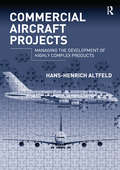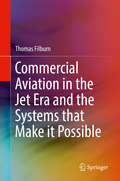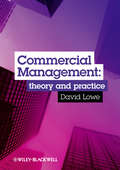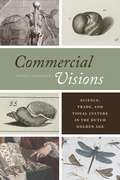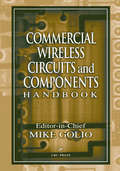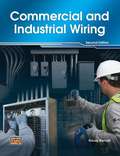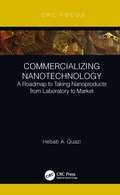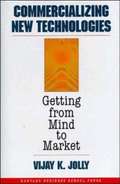- Table View
- List View
Commemorating War: The Politics of Memory
by Graham Dawson Timothy G. Ash PlantWar memory and commemoration have had increasingly high profiles in public and academic debates in recent years. This volume examines some of the social changes that have led to this development, among them the passing of the two world wars from survivor into cultural memory. Focusing on the politics of war memory and commemoration, the book illuminates the struggle to install particular memories at the center of a cultural world, and offers an extensive argument about how the politics of commemoration practices should be understood.Commemorating War analyzes a range of forms of remembrance, from public commemorations orchestrated by nation-states to personal testimonies of war survivors; and from cultural memories of war represented in films, plays and novels to investigations of wartime atrocities in courts of human rights. It presents a wide range of international case studies, encompassing lesser-known national histories and wars beyond the well-trodden terrain of Vietnam and the two world wars in Europe.Emerging from this book is an important critique of both "state-centered" approaches to war memory and those that regard commemoration primarily as a human response to loss and grief. Offering a wealth of empirical research material, this book will be important for cultural and oral historians, sociologists, researchers in international relations and human rights, and anybody with an interest in the cultural construction of memory in contemporary society.
Comment Publier Un E-Book Sans Perdre La Tête (Et Faire En Sorte Que Quelqu'un Le Lise)
by Alejandro Aguayo Lisa SchwartzSi vous avez fait l'acquisition de cet e-book, c'est parce que vous souhaitez publier un livre. Félicitations, vous avez déjà fait le plus important : prendre la décision.
Comment gagner de l'argent avec l'impression 3D: la nouvelle révolution numérique
by Adidas WilsonAlors que l'impression 3D est de plus en plus populaire, de nombreuses personnes gagnent une fortune et la font grandir dans l'industrie. Une telle réalisation n'est peut-être pas un jeu d'enfant, mais chercher des moyens de faire une percée est de loin le seul moyen d'y parvenir et de réaliser ce que les autres ont conceptualisé en moyens de gagner de l'argent. Si vous avez toujours été intéressé par l'impression 3D et que vous souhaitez gagner de l'argent avec cette technologie, il est temps que vous travailliez intelligemment pour relever les défis à venir. Les modèles imprimables en 3D peuvent être créés avec un package de conception assistée par ordinateur (CAO), via un scanner 3D ou par un appareil photo numérique et un logiciel de photogrammétrie. Les modèles imprimés en 3D créés avec la CAO réduisent les erreurs et peuvent être corrigés avant l'impression, ce qui permet de vérifier la conception de l'objet avant son impression.
Commercial Aircraft Projects: Managing the Development of Highly Complex Products
by Hans-Henrich AltfeldWhen it comes to very highly complex, commercially funded product-development projects it is not sufficient to apply standard project management techniques to manage and keep them under control. Instead, they need a project management approach which is perfectly adapted to their complex nature. This, however, may generate additional cost and a dilemma arises because in commercially-driven product developments there is the natural tendency to limit the management-related costs. The development of a new commercial aircraft is no exception. In fact, it can be regarded as an extreme example of this kind of project. This is why it is especially useful to analyse the project management capabilities and practices needed to manage them. Cost reductions can still be achieved by concentrating on the essential elements of some project management disciplines, to maintain their principal strengths, and combining them in a pragmatic way on the basis of an integrated architecture. This book goes beyond descriptions of management disciplines found elsewhere in its treatment of the architecture integration necessary to interlink product, process and resources data. Only with this connectedness can the interoperation of the management essentials yield maximum efficiency and effectiveness. Commercial Aircraft Projects: Managing the Development of Highly Complex Products proposes an integrated architecture and details, step-by-step, how it can be used for the management of commercial aircraft development projects. The findings can also be applied to other industrial sectors that produce complex hardware based on design inputs.
Commercial Applications of Ionic Liquids (Green Chemistry and Sustainable Technology)
by Mark B. ShiflettThis book provides an overview of the current and emerging industrial applications of ionic liquids, covering the core processes, the practical implementation and technical challenges involved, and exploring potential future directions for research and development.The introductory chapter describes the unique physical and chemical properties of ionic liquids, and illustrates the vast potential for application of these materials across the industrial landscape. Following this, individual chapters written by leading figures from industry and academia address specific processes and products, such as the development of a new chloroaluminate ionic liquid as an alkylation catalyst and a new class of capillary gas chromatography (GC) columns with stationary phases based on ionic liquids.Over the past twenty years, ionic liquids have moved from being considered as mere academic curiosities to having genuine applications in fields as wide-ranging as biotechnology, biorefineries, catalysis, pharmaceuticals, renewable fuels, and sustainable energy. This book highlights several commercial products and processes that use or will soon be using ionic liquids.
Commercial Astronauts: The Next Generation of Spacefarers (Springer Praxis Books)
by Erik SeedhouseThe beginning of the 2020’s witnessed dozens of commercial astronauts fly to space on a variety of vehicles. These spacecraft included SpaceX’s Crew Dragon, which supported the Inspiration4 and Axiom Space missions, Virgin Galactic’s SpaceShipTwo, which supported several suborbital science flights, and Blue Origin’s New Shepard spacecraft, which not only flew celebrities but also its fair share of commercial astronauts. The story of this new breed of spacefarer has only just begun. As evidenced by these missions, commercial spaceflight has grown beyond passengers simply traveling to space just for the ride. With orbital flights involving commercial astronauts staying in space for several days and weeks, companies such as Sierra Space, Axiom Space and Blue Origin are preparing for the next steps in commercial space travel which include the construction of orbiting habitats. But how will the opportunities for commercial astronauts develop, how will they be trained, and will this new group of astronauts evolve? This book describes how the commercial spaceflight industry is evolving, how it will continue to evolve as barriers to entry are reduced, competition grows, and costs are lowered, and how, because of these efforts, opportunities for commercial astronauts will increase.
Commercial Aviation in the Jet Era and the Systems that Make it Possible
by Thomas FilburnThis book discusses the multiple systems that make commercial jet travel safe and convenient. The author starts by tracing the evolution of commercial jets from the Boeing 707 to the double decker Airbus A380. The next 7 chapters discuss flight controls, along with the high lift surfaces (flaps and slats) that are essential to allow high speed, low drag aircraft to take-off and land. The other systems include Engines/Nacelles, Cabin Pressurization and Air Conditioning systems, Landing Gear and brakes, Fuel Systems, Instruments/Sensors, and finally Deicing systems for the wings, nacelles and external air speed sensors. Case studies describe a significant accident that arose from a failure in the various systems described. The final chapter summarizes the past 60 years of jet travel and describe how these systems have created a cheaper, safer mode of travel than any other.
Commercial Conflict Management and Dispute Resolution
by Peter FennCommerce is inherently complex and the sums of money involved can be astronomical, so it is no surprise that conflicts and disputes are all too common. There are numerous techniques designed to resolve these problems, and this book summarizes the most important of these, as well as alternative dispute resolution methods. The reader seeking a deeper understanding of these procedures will also find clear explanations of the principles and methods for conflict management, such as negotiation, risk management, mediation and conciliation. As well as outlining these different techniques, guidance on which approach is appropriate in common situations is also given, helping the reader apply what they have learned to the real world. The significance of cultural issues is explained, before the reader is presented with suggestions for how to take these into account. Throughout, the book is illustrated with case studies from examples as diverse as Mumbai's DabbaWalla, The First World War and Terminal 5 at London Heathrow. Written with undergraduate students in mind, this book also serves to give a neat and brief overview for professionals. Those studying or working in commerce generally, construction project management, construction management, and construction law will find this to be an invaluable book.
Commercial Cool Storage Design Guide
by Electric Power Research InstituteThis handbook provides comprehensive guidance for designing ice and chilled-water storage systems for commercial buildings. It contains state-of-the-art information necessary to evaluate the cost-effectiveness of cool storage options and select, configure, and screen system alternatives.
Commercial Design Using Autodesk Revit 2020
by Daniel John StineCommercial Design Using Autodesk Revit 2020 is designed for the architectural student using Revit 2020. The intent is to provide you with a well-rounded knowledge of tools and techniques for use in both school and industry. This text takes a project based approach to learning Revit's architectural tools in which you develop a three story office building. Each book also includes access to nearly 100 video tutorials designed to further help you master Autodesk Revit. General building codes and industry standard conventions are covered in a way that is applicable to the current exercise. <p><p> The first two chapters are intended to get you familiar with the user interface and many of the common menus and tools of Revit 2020. A small office is created in chapter two to show you just how easy it is to get started using Autodesk Revit. By the end of chapter two you will be excited and prepared to take on a much larger project. <p><p> Throughout the rest of the book you develop a three story office building. The drawings start with the floor plans and develop all the way to photo-realistic renderings like the one on the cover of this book. In these chapters many of the architectural tools and features of Revit 2020 are covered in greater detail.
Commercial Management
by David LoweCommercial Management: theory and practice defines the role of commercial management within project-oriented organisations, providing a framework for and helping to develop a critical understanding of the factors that influence commercial management practice. It also identifies generic aspects of this practice and provides a theoretical foundation to these activities, by reference to existing and emergent theories and concepts, as well as to relevant management best practice. The book is structured into four parts: Part 1 Introduction - Commercial Management in Project Environments explores the nature of commercial practice within project-oriented organisations at the buyer-seller interface. It presents a Commercial Management framework, which illustrates the multiple interactions and connections between the purchaser's procurement cycle and a supplier's bidding and implementation cycles. Additionally, it outlines the principle activities undertaken by the commercial function, identifies the skills and abilities that support these activities and reviews the theories and concepts that underpin commercial practice. Finally, it identifies areas of commonality of practice with other functions found within project-oriented organisations, plus sources of potential conflict and misunderstanding. Part 2 - Elements of Commercial Theory and Practice covers commercial leadership; exploring strategy; risk and uncertainty management; financial decision-making; and key legal issues. Part 3 - Approaches to Commercial Practice addresses best practice management; and commercial and contracting strategies and tactics. Finally, Part 4 - Case Studies offers two extended case studies: Football Stadia (the Millennium Stadium, Cardiff; the Emirates Stadium, Islington; and Wembley Stadium, London); and Heathrow Terminal 5. The book provides a one-stop-shop to the many topics that underpin commercial management practice from both a demand (buy-side) and a supply (sell-side) perspective. It will help develop an understanding of the issues influencing commercial management: leadership, strategy, risk, financial, legal, best practice management and commercial and contracting strategy and tactics. This book's companion website is at www. wiley. com/go/lowecommercialmanagement and offers invaluable resources for both students and lecturers: * PowerPoint slides for lecturers on each chapter * Sample exam questions for students to practice * Weblinks to key journals and relevant professional bodies
Commercial Space Technologies and Applications: Communication Remote Sensing Gps And Metrological Satellites Second Edition
by Mohammad RazaniThis new edition introduces and examines the space technologies that benefit our everyday lives. Each chapter now includes exercises and problems, and the content covers new satellites and emerging technologies. It explores the ever-improving quality of satellite systems and services, and also investigates ways to bring about higher resolution satellite imagery and lower satellite costs. The focus is on man-made satellites, which are becoming smaller, smarter, cheaper, and easier to launch, having a longer life span, and are less susceptible to interference. Furthermore, the book considers advances in several key technologies that affect the satellite industry. Includes extensive study questions and exercises after each chapter. Explains present commercial space technology and its future outlook. Explores the many applications of space technologies and their impact on our lives, including real world examples. Presents a future outlook on robotics, communications and navigation, and human health and nanotechnology. Provides a clear understanding of space, space technologies, space applications, space security, space regulations, a space roadmap, and their impact on the lives of humans now and for generations to come.
Commercial Status of Plant Breeding in India
by Aparna TiwariPlant breeding has the potential to improve quality of life for millions of people, and to harmoniously link agriculture, societies and ecosystems. Global efforts have been made to improve awareness and create a better and brighter future for plant breeding worldwide. Though substantial international research funding is available, and tremendous efforts have been made to achieve food security and sustainability in agriculture, their success can only be ensured when they are complemented by counterparts at the national level. India is ideally poised to reap the benefits of plant breeding by integrating various parameters like adaptation, uncertainty, vulnerability and resilience into agriculture research strategies. Priorities include making agriculture more appealing to young talents, formulating farmer-friendly policies, combining advanced technologies with conventional plant breeding practices, and building the competencies needed to address emerging challenges in agriculture. This book provides an essential overview of modern plant breeding, and demonstrates how education, entrepreneurship training and professional approaches can help transform the image of agriculture from a poor and unattractive domain into a lucrative and business-oriented one. In addition, it presents strategies to help achieve sustainable, accessible and affordable outcomes with breeding programs. The book’s primary goal is to encourage policymakers, academics, private institutions and non-profit organizations to combine their efforts in order to achieve a major transition in plant breeding activities in Asia. Accordingly, it highlights the importance of partnerships and collaborations for making breeding programs more comprehensive and meaningful.
Commercial Visions: Science, Trade, and Visual Culture in the Dutch Golden Age
by Dániel MargócsyEntrepreneurial science is not new; business interests have strongly influenced science since the Scientific Revolution. In Commercial Visions, Dániel Margócsy illustrates that product marketing, patent litigation, and even ghostwriting pervaded natural history and medicine--the "big sciences” of the early modern era--and argues that the growth of global trade during the Dutch Golden Age gave rise to an entrepreneurial network of transnational science. Margócsy introduces a number of natural historians, physicians, and curiosi in Amsterdam, London, St. Petersburg, and Paris who, in their efforts to boost their trade, developed modern taxonomy, invented color printing and anatomical preparation techniques, and contributed to philosophical debates on topics ranging from human anatomy to Newtonian optics. These scientific practitioners, including Frederik Ruysch and Albertus Seba, were out to do business: they produced and sold exotic curiosities, anatomical prints, preserved specimens, and atlases of natural history to customers all around the world. Margócsy reveals how their entrepreneurial rivalries transformed the scholarly world of the Republic of Letters into a competitive marketplace. Margócsy’s highly readable and engaging book will be warmly welcomed by anyone interested in early modern science, global trade, art, and culture.
Commercial Wireless Circuits and Components Handbook
by Mike GolioA comprehensive source for microwave and wireless circuit design, the Commercial Wireless Circuits and Components Handbook reviews the fundamentals of transmitters and receivers, then presents detailed chapters on individual circuit types. It also covers packaging, large and small signal characterization, and high volume testing techniques for both devices and circuits. This handbook not only provides important information for engineers working with wireless RF or microwave circuitry, it also serves as an excellent source for those requiring information outside of their area of expertise, such as managers, marketers, and technical support workers who need a better understanding of the fields driving their decisions.
Commercial and Industrial Wiring
by Randy Barnett ; American Technical Publishers. Inc.Commercial and Industrial Wiring focuses on the installation and maintenance of electrical wiring in commercial and industrial facilities. The textbook covers the use of standards, codes, electrical drawings, and appropriate tools to safely and properly install and maintain raceway systems, enclosures, fittings, conductors, and devices.
Commercial-Industrial Cleaning, by Pressure-Washing, Hydro-Blasting and UHP-Jetting: The Business Operating Model and How-To Manual for 450 Specific Applications
by Wolfgang MaasbergCommercial-Industrial Cleaning, by Pressure-Washing, Hydro-Blasting and UHP-Jetting is the first proprietary manual for cleaning and rehabilitation through pressure-washing, hydro-blasting and ultra high pressure water jetting (UHP). It examines the cleaning, restoration and rehabilitation of statuary and historical structures; manufacturing hardware; and application technologies for residential, commercial and industrial areas, structures and buildings. Commercial-Industrial Cleaning, by Pressure-Washing, Hydro-Blasting and UHP-Jetting contains over 450 applications from agricultural, marine, municipal, food processing, paper-pulp, pharmaceutical and cosmetic, industrial and power generating maintenance areas. It includes gear lists to help readers easily identify the appropriate tooling and equipment for each specific application and industry. Commercial-Industrial Cleaning, by Pressure-Washing, Hydro-Blasting and UHP-Jetting supplies readers with the tools to create a successful business model for retaining and safeguarding corporate application itineraries. It is a valuable guide for maintenance superintendents, buyers of maintenance services, contractors, field technicians, engineers and architects involved in commercial-industrial cleaning.
Commercialization Secrets for Scientists and Engineers
by Michael SzycherCommercializing a knowledge-based product or service requires a realistic, methodical approach combined with a great deal of perseverance. Commercialization Secrets for Scientists and Engineers serves as a high-level guide to answering key questions and critical issues that confront founding entrepreneurs on their quest to commercialize their knowledge-based innovations. It highlights the unique problems shared by all technologists across knowledge-intensive fields and how to overcome the most predictable obstacles faced by technology entrepreneurs. It demystifies the process of commercializing advanced products that require a high degree of specialized knowledge. Typically, these are "disruptive technologies" with the potential to revolutionize whole industries. The book simplifies the launch of high-tech ventures such as pharmaceuticals, genetic and biotechnology products, wireless devices, fuel cells, and minimally invasive medical devices. Additionally, it will help readers bring their disruptive technologies to profitability.
Commercialization of Nanotechnologies–A Case Study Approach: A Case Study Approach
by Fatima Zivic Eva Pellicer Jordi Sort Nenad Grujovic Dermot Brabazon Maria Dolors Baró Kwang-Leong ChoyThis book covers diverse areas in which nanoscience and nanotechnology have led to significant technological advances and practical applications, with special emphasis on novel types of nanomaterials and their applicability into a new generation of nano- and micro-devices. Different nanomaterials are reviewed with a focus on several practical application areas and their commercial utilization. Production technologies of nanomaterials are presented as one of the challenges today. Sectors where nanotechnology has already significantly contributed are presented, along with specific nanotechnology solutions: energy related sectors, NEMS/MEMS, micro power generators, spintronics and healthcare. The basic properties and applications of nanostructured thermoelectric materials, ferroelectric and piezoelectric nanomaterials are reviewed. Examples of several developed thin-film thermogenerators are shown. A review of existing solutions and developing challenges are given regarding sustainable energy production, photovoltaics, solar cells, hydrogen economy and improved classes of batteries as contributions to green products and circular economy. Novel, highly promising areas in nanotechnology, are shown, such as voltage-driven nano-spintronics. Recent advances in friction characterisation at the nano level are described. Several proven nanomaterials have been reviewed pertaining to biomedicine. The use of nanomaterials in ophthalmology and cosmetic industry are reviewed, and the potential for silver nanoparticles and iron-based nanomaterials in biomedicine, also with recognised challenges and possible threats of non-controlled use of nanomaterials. This work is the result of joint efforts of different companies, academic, and research institutions participating in WIMB Tempus project, 543898-TEMPUS-1-2013-1-ES-TEMPUS-JPHES, "Development of Sustainable Interrelations between Education, Research and Innovation at WBC Universities in Nanotechnologies and Advanced Materials where Innovation Means Business", co-funded by the Tempus Programme of the European Union.
Commercializing Micro-Nanotechnology Products
by Mark J. Jackson David TolfreeMicro-nanotechnologies (MNT) are already making a profound impact on our daily lives. New applications are well underway in the US, Asia, and Europe. However, their potentially disruptive nature, along with the public's concerns, has produced a number of challenges. Commercializing Micro-Nanotechnology Products provides a snapshot of the cur
Commercializing Nanotechnology: A Roadmap to Taking Nanoproducts from Laboratory to Market
by Hebab A. QuaziCommercializing Nanotechnology: A Roadmap to Taking Nanoproducts from Laboratory to Market provides a step-by-step roadmap for taking the results of laboratory research on nanotechnology and nanomaterials and developing them into successful and profitable commercial ventures. It details the methodology, techniques, and pathways for technology-readiness assessment, testing protocols, and commercialization, and it discusses manufacturing techniques, including their limitations and challenges. Provides methodology, techniques, and pathways for technology-readiness assessment, testing protocols, and commercialization Offers general direction and assistance to researchers Describes manufacturing techniques, including their limitations and challenges Discusses intellectual property protection Provides details on market opportunities This book is aimed at scientists and engineers, including chemists, physicists, economists, medical practitioners, managers, marketers, traders, investors, and entrepreneurs in the fields of nanoscience, nanomedicine, nanoengineering, and nanomanufacturing.
Commercializing New Technologies: Getting from Mind to Market
by Vijay K. JollyThe author tackles the issue of technology commercialization, characterizing it as a dynamic process that proceeds through five stages: 1) imagining, 2) incubating, 3) demonstrating, 4) promoting, and 5) sustaining.
Commercializing Successful Biomedical Technologies: Basic Principles For The Development Of Drugs, Diagnostics And Devices
by Shreefal S. MehtaTransform your research into commercial biomedical products with this revised and updated second edition. Covering drugs, devices and diagnostics, this book provides a step-by-step introduction to the process of commercialization, and will allow you to create a realistic business plan to develop your ideas into approved biomedical technologies. This new edition includes: Over 25% new material, including practical tips on startup creation from experienced entrepreneurs. Tools for starting, growing and managing a new venture, including business planning and commercial strategy, pitching investors, and managing operations. Global real-world case studies, including emerging technologies such as regulated medical software and Artificial Intelligence (AI), offer insights into key challenges and help illustrate complex points. Tips and operational tools from established industry insiders, suitable for graduate students and new biomedical entrepreneurs.
Commit to Safe & Efficient Operations
by Kris Callen"Commit to Safe and Efficient Operations" is a road-map (recipe) for transforming your organization, division or team's safety culture.
Commodities Pricing and the Bulk Trap: Learnings from Industries at the Forefront
by Fredrik Andrén-SandbergThis book takes a fresh look at pricing, product differentiation and the need for decommoditisation in market sectors where products and services are standardised and interchangeable. In the first chapters the book explains what commodities are, and puts them into a historical perspective to promote an understanding of their production and its effects. From this baseline the book then presents a case study on how decommoditisation has progressed within the energy industry. Building on this case study and learnings from other sectors, it develops a theoretical framework, characterising the processes and mechanisms observed to be extended towards different industries. This framework is then utilised in the following chapters as a model to explain the progression of decommoditisation, and to examine other sectors through this lens. To conclude, the book presents the implications for stakeholders and suggestions on how to respond to them from a policy and business standpoint. In a final chapter the book develops an outlook on current trends and possible alternative pathways, and summarizes the main takeaways for management professionals and policymakers alike.



